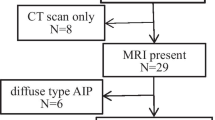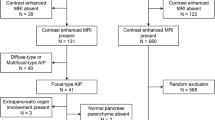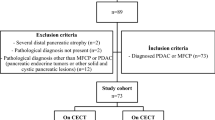Abstract
Objectives
To evaluate the value of dynamic enhancement patterns on contrast-enhanced MR images by adding signal intensity colour mapping (SICM) to differentiate mass-forming focal pancreatitis (MFFP) from pancreatic ductal adenocarcinoma (PDAC).
Methods
Forty-one clinicopathologically proven MFFPs and 144 surgically confirmed PDACs were enrolled. Laboratory and MR imaging parameters were used to differentiate MFFP from PDAC. In particular, enhancement patterns on MR images adding SICM were evaluated. By using classification tree analysis (CTA), we determined the predictors for the differentiation of MFFP from PDAC.
Results
In the CTA, with all parameters except enhancement pattern on SICM images, ductal obstruction grade and T1 hypointensity grade of the pancreatic lesion were the first and second splitting predictor for differentiation of MFFP from PDAC, in order. By adding an enhancement pattern on the SICM images to CTA, the enhancement pattern was the only splitting predictor to differentiate MFFP from PDAC. The CTA model including enhancement pattern on SICM images has sensitivity of 78.0 %, specificity of 99.3 %, and accuracy of 94.6 % for differentiating MFFP from PDAC.
Conclusion
The characterization of enhancement pattern for pancreatic lesions on contrast-enhanced MR images adding SICM would be helpful to differentiate MFFP from PDAC.
Key Points
• SICM was useful to characterize enhancement pattern.
• Enhancement pattern on SICM was the only splitting predictor on CTA.
• This model may be useful for differentiating MFFP from PDAC.





Similar content being viewed by others
Abbreviations
- PDAC:
-
Pancreatic ductal adenocarcinomas
- MFFP:
-
Mass-forming focal pancreatitis
- CBD:
-
Common bile duct
- MPD:
-
Main pancreatic duct
- SICM:
-
Signal intensity colour mapping
- MR:
-
Magnetic resonance
- DWI:
-
Diffusion-weighted imaging
- ADC:
-
Apparent diffusion coefficient
- CTA:
-
Classification tree analysis
References
Sugiyama Y, Fujinaga Y, Kadoya M et al (2012) Characteristic magnetic resonance features of focal autoimmune pancreatitis useful for differentiation from pancreatic cancer. Jpn J Radiol 30:296–309
Hur BY, Lee JM, Lee JE et al (2012) Magnetic resonance imaging findings of the mass‐forming type of autoimmune pancreatitis: Comparison with pancreatic adenocarcinoma. J Magn Reson Imaging 36:188–197
Servais A-M, Pestieau SR, Detry O et al (2001) Autoimmune pancreatitis mimicking cancer of the head of pancreas: report of two cases. Acta Ggastroenterol Belg 64:227–230
Hardacre JM, Iacobuzio-Donahue CA, Sohn TA et al (2003) Results of pancreaticoduodenectomy for lymphoplasmacytic sclerosing pancreatitis. Ann Surg 237:853–859
Abraham SC, Wilentz RE, Yeo CJ et al (2003) Pancreaticoduodenectomy (Whipple resections) in patients without malignancy: Are they AllChronic Pancreatitis'? Am J Surg Pathol 27:110–120
Kennedy T, Preczewski L, Stocker SJ et al (2006) Incidence of benign inflammatory disease in patients undergoing Whipple procedure for clinically suspected carcinoma: a single-institution experience. Am J Surg 191:437–441
Rasheed ZA (2012) Pathology of pancreatic stroma in PDAC. In : Grippo PJ, Munshi HG (eds) Pancreatic Cancer and Tumor Microenvironment Trivandrum (India), Transworld Research Network, Available via http://www.ncbi.nlm.nih.gov/books/NBK98933/
Apte M, Park S, Phillips P et al (2004) Desmoplastic reaction in pancreatic cancer: role of pancreatic stellate cells. Pancreas 29:179–187
Korc M (2007) Pancreatic cancer–associated stroma production. Am J Surg 194:S84–S86
Kim SA, Lee JM, Lee KB et al (2011) Intrahepatic mass-forming cholangiocarcinomas: enhancement patterns at multiphasic CT, with special emphasis on arterial enhancement pattern—correlation with clinicopathologic findings. Radiology 260:148–157
Chari ST, Kloeppel G, Zhang L et al (2010) Histopathologic and clinical subtypes of autoimmune pancreatitis: the Honolulu consensus document. Pancreatology 10:664–672
Shimosegawa T, Chari ST, Frulloni L et al (2011) International consensus diagnostic criteria for autoimmune pancreatitis: guidelines of the International Association of Pancreatology. Pancreas 40:352–358
Haradome H, Grazioli L, Tsunoo M et al (2010) Can MR fluoroscopic triggering technique and slow rate injection provide appropriate arterial phase images with reducing artifacts on gadoxetic acid-DTPA (Gd-EOB-DTPA)-enhanced hepatic MR imaging? J Magn Reson Imaging 32:334–340
Nitta T, Mitsuhashi T, Hatanaka Y, Hirano S, Matsuno Y (2013) Pancreatic ductal adenocarcinomas with multiple large cystic structures: A clinicopathologic and immunohistochemical study of seven cases. Pancreatology 13:401–408
Kosmahl M, Pauser U, Anlauf M, Klöppel G (2005) Pancreatic ductal adenocarcinomas with cystic features: neither rare nor uniform. Mod Pathol 18:1157–1164
Kim HJ, Kim YK, Jeong WK, Lee WJ, Choi D (2015) Pancreatic duct “Icicle sign” on MRI for distinguishing autoimmune pancreatitis from pancreatic ductal adenocarcinoma in the proximal pancreas. Eur Radiol 25:1551–1560
Fattahi R, Balci NC, Perman WH et al (2009) Pancreatic diffusion‐weighted imaging (DWI): comparison between mass‐forming focal pancreatitis (FP), pancreatic cancer (PC), and normal pancreas. J Magn Reson Imaging 29:350–356
Sun G-F, Zuo C-J, Shao C-W, Wang J-H, Zhang J (2013) Focal autoimmune pancreatitis: radiological characteristics help to distinguish from pancreatic cancer. World J Gastroenterol 19:3634–3641
Negrelli R, Manfredi R, Pedrinolla B et al (2015) Pancreatic duct abnormalities in focal autoimmune pancreatitis: MR/MRCP imaging findings. Eur Radiol 25:359–367
Park MJ, Kim YK, Choi S-y, Rhim H, Lee WJ, Choi D (2014) Preoperative detection of small pancreatic carcinoma: value of adding diffusion-weighted imaging to conventional MR imaging for improving confidence level. Radiology 273:433–443
Breiman L (2001) Random forests. Mach Learn 45:5–32
Ichikawa T, Sou H, Araki T et al (2001) Duct-penetrating sign at MRCP: usefulness for differentiating inflammatory pancreatic mass from pancreatic carcinomas 1. Radiology 221:107–116
Carbognin G, Girardi V, Biasiutti C et al (2009) Autoimmune pancreatitis: imaging findings on contrast-enhanced MR, MRCP and dynamic secretin-enhanced MRCP. Radiol Med 114:1214–1231
Furuhashi N, Suzuki K, Sakurai Y, Ikeda M, Kawai Y, Naganawa S (2015) Differentiation of focal-type autoimmune pancreatitis from pancreatic carcinoma: assessment by multiphase contrast-enhanced CT. Eur Radiol 25:1366–1374
Gangi S, Fletcher J, Nathan MA et al (2004) Time interval between abnormalities seen on CT and the clinical diagnosis of pancreatic cancer: retrospective review of CT scans obtained before diagnosis. AJR Am J Roentgenol 182:897–903
Kamisawa T, Notohara K, Shimosegawa T (2010) Two clinicopathologic subtypes of autoimmune pancreatitis: LPSP and IDCP. Gastroenterology 139:22–25
Lee SS, Byun JH, Park BJ et al (2008) Quantitative analysis of diffusion‐weighted magnetic resonance imaging of the pancreas: Usefulness in characterizing solid pancreatic masses. J Magn Reson Imaging 28:928–936
Huang WC, Sheng J, Chen SY, Lu JP (2011) Differentiation between pancreatic carcinoma and mass‐forming chronic pancreatitis: Usefulness of high b value diffusion‐weighted imaging. J Dig Dis 12:401–408
Barral M, Taouli B, Guiu B et al (2014) Diffusion-weighted MR imaging of the pancreas: current status and recommendations. Radiology 274:45–63
Klau M, Lemke A, Grünberg K et al (2011) Intravoxel incoherent motion MRI for the differentiation between mass forming chronic pancreatitis and pancreatic carcinoma. Invest Radiol 46:57–63
Kang KM, Lee JM, Yoon JH, Kiefer B, Han JK, Choi BI (2014) Intravoxel incoherent motion diffusion-weighted MR imaging for characterization of focal pancreatic lesions. Radiology 270:444–453
Swords DS, Mone MC, Zhang C, Presson AP, Mulvihill SJ, Scaife CL (2015) Initial misdiagnosis of proximal pancreatic adenocarcinoma is associated with delay in diagnosis and advanced stage at presentation. J Gastrointest Surg 19:1813–1821
El Malki HO, El Mejdoubi Y, Souadka A et al (2010) Predictive model of biliocystic communication in liver hydatid cysts using classification and regression tree analysis. BMC Surg. doi:10.1186/1471-2482-10-16
Thomassin-Naggara I, Toussaint I, Perrot N et al (2011) Characterization of complex adnexal masses: value of adding perfusion-and diffusion-weighted MR imaging to conventional MR imaging. Radiology 258:793–803
Nunes LW, Schnall MD, Orel SG (2001) Updat;e of breast MR imaging architectural interpretation model 1. Radiology 219:484–494
Acknowledgments
The scientific guarantor of this publication is Won Jae Lee, the head of radiology department. The authors of this manuscript declare no relationships with any companies, whose products or services may be related to the subject matter of the article. The authors state that this work has not received any funding. One of the authors has significant statistical expertise, Kyunga Kim. Institutional review board approval was obtained. Written informed consent was waived by the Institutional review board. No study subjects or cohorts have been previously reported
Author information
Authors and Affiliations
Corresponding author
Rights and permissions
About this article
Cite this article
Kim, M., Jang, K.M., Kim, JH. et al. Differentiation of mass-forming focal pancreatitis from pancreatic ductal adenocarcinoma: value of characterizing dynamic enhancement patterns on contrast-enhanced MR images by adding signal intensity color mapping. Eur Radiol 27, 1722–1732 (2017). https://doi.org/10.1007/s00330-016-4522-0
Received:
Revised:
Accepted:
Published:
Issue Date:
DOI: https://doi.org/10.1007/s00330-016-4522-0




